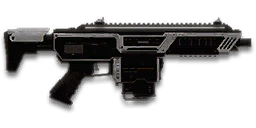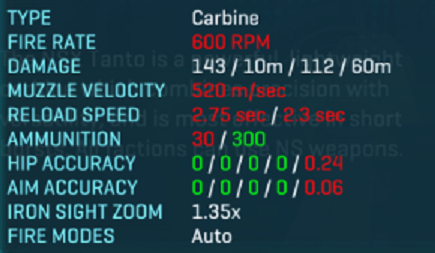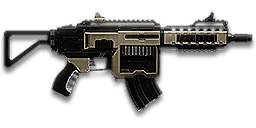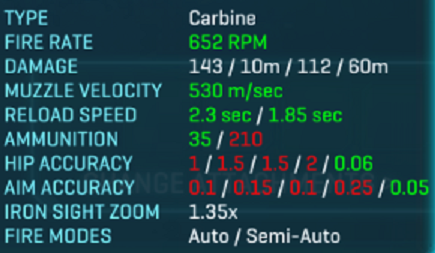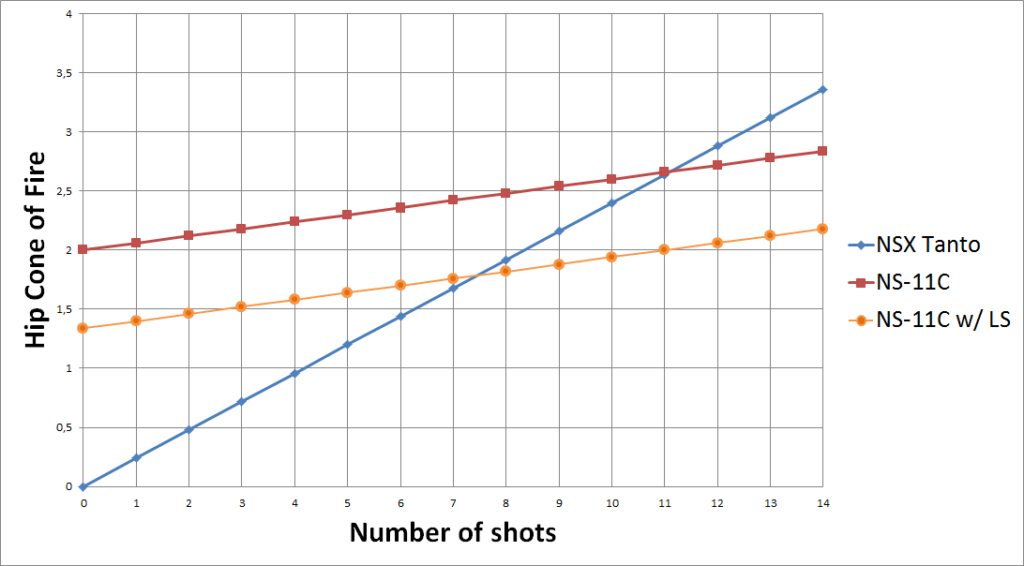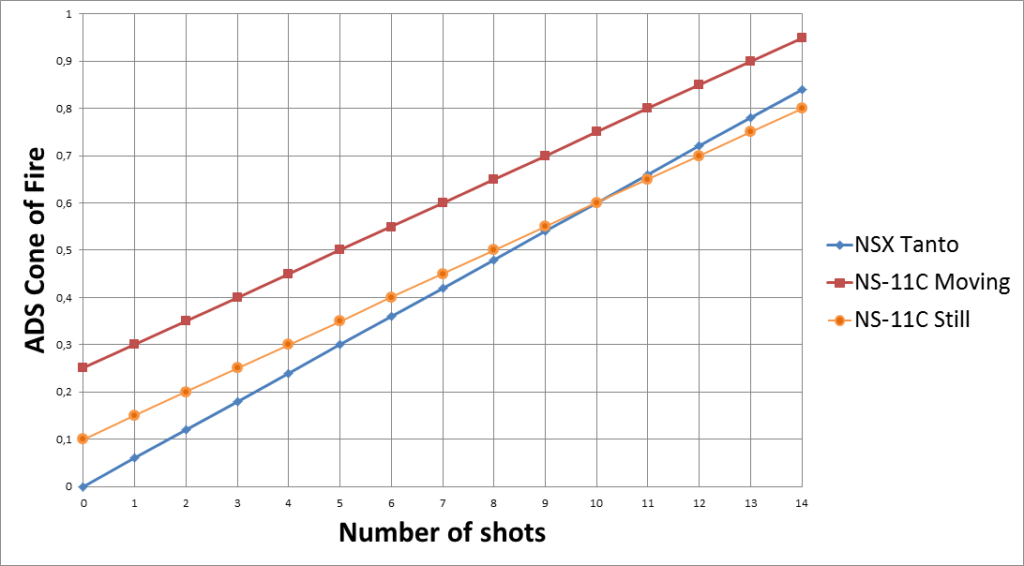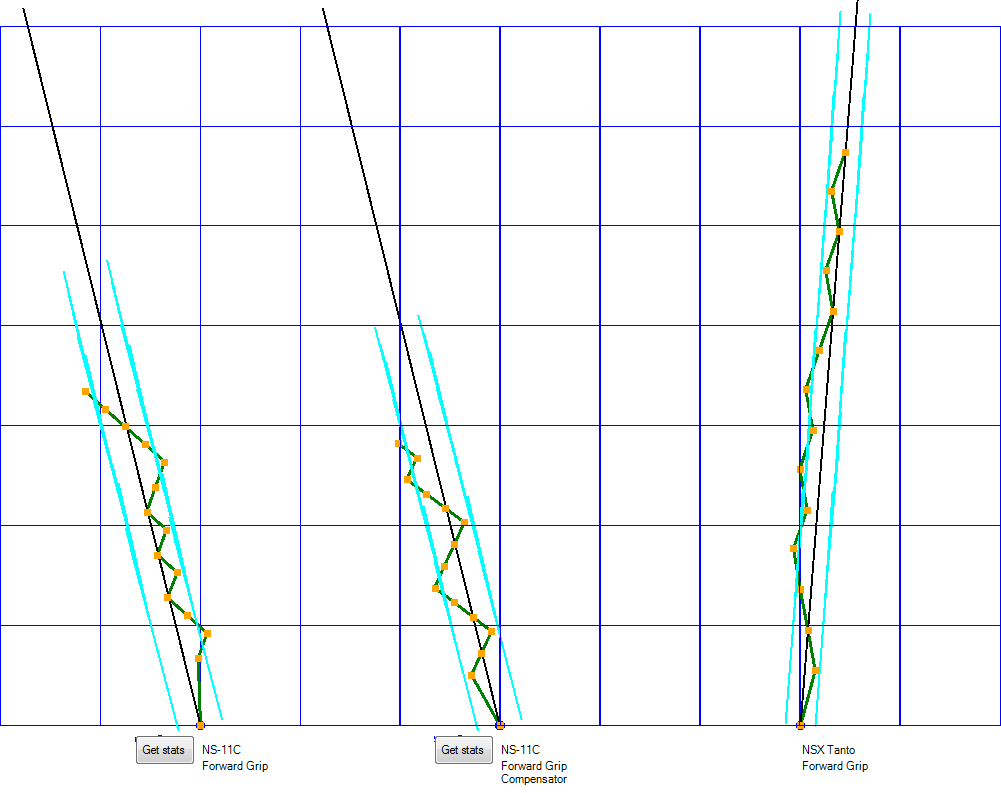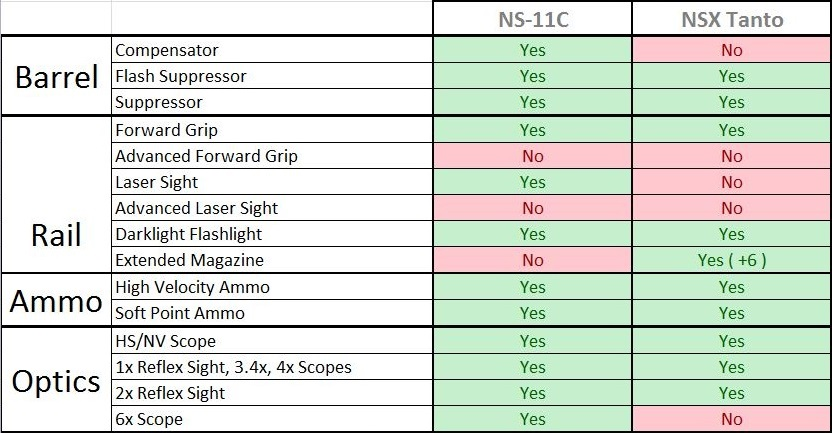At the moment there are four similar LMGs that share the 143 @ 698 damage model. Namely, those are:
T9 CARV-S – the TR’s “adaptable” LMG, which has a large selection of attachments. Never was popular.
SVA-88 – the faded star of the VS arsenal, which used to offer 75% ADS speed, same as Orion, but with better controllability. The weapon has been rebalanced since then, and fell behind the Pulsar LSW in terms of viability.
Pulsar LSW – can be treated as a slightly more CQC-oriented version of SVA-88 with a different recoil pattern and attachment selection.
MGR-L1 Promise – a newly released NC LMG with an exquisite and unique model, artfully crafted by /u/d0ku. The general theme of the weapon is ease of use and controllability over time, with some stats and mechanics intended to make sustained fire less punishing.
Let’s take a closer look and figure out if any of these weapons are worth using, and what circumstances would benefit them the most.
Stats
Damage Output
All of these LMGs share the damage model of 143 @ 10m – 112 @ 65m, which puts them in a weird place.
At range, they deal carbine-tier damage, and cannot really compete with weapons that deal more damage per shot, even if they’re not specialized towards ranged combat. It feels that you cannot kill an enemy 50m away without filing a notice two weeks in advance.
On the other hand, strictly average DPS makes them inferior in close quarters combat.
Historically, weapons like that are shunned by players, and for a good reason. You would think that being average would make them versatile, and give them passable performance in every situation, but in reality it rather makes them mediocre.
SPA and HVA are available to some of these LMGs, and they’ll have an impact on their performance:

| CARV-S | Pulsar LSW | SVA-88 | Promise | |
| SPA | YES | NO | NO | NO |
| HVA | YES | NO | YES | NO |
Notes:
- At best, SPA provides a 2% DPS boost or a 0.086 second TTK reduction at 15m.
- At best, HVA provides a 7% DPS boost at 65m, or a 0.086 second TTK reduction between 42m and 52m.
- In terms of damage per bullet, HVA overtakes SPA at 30m.
Bullets-to-Kill and Time-to-Kill
Standard Infantry
| BTK | Distance, meters | Time to Kill, seconds | Target | ||
| Stock | SPA | HVA | |||
| 4 | 0 – 41 | 0 – 44 | 0 – 52 | 0.258 | Headshots |
| 5 | 42+ | 45+ | 53+ | 0.344 | |
| 7 | 0 – 10 | 0 – 15 | 0 – 8 | 0.516 | Standard Infantry |
| 8 | 11 – 41 | 16 – 44 | 9 – 52 | 0.602 | |
| 9 | 42+ | 45+ | 53+ | 0.688 | |
| 9 | 0 – 17 | 0 – 21 | 0 – 17 | 0.688 | Nanoweave |
| 10 | 18 – 41 | 22 – 44 | 18 – 52 | 0.774 | |
| 11 | 42 – 61 | 45 – 61 | 53 – 80 | 0.860 | |
| 12 | 62+ | 62+ | 81+ | 0.946 | |
Heavy Assault
For the sake of brevity, BTK and TTK are listed only for the first threshold.
| BTK | Distance, meters | Time to Kill, seconds | Target | ||
| Stock | SPA | HVA | |||
| 6 | 0 – 50 | 0 – 52 | 0 – 65 | 0.430 | NMG / Adrenaline + Headshots |
| 6 | 0 – 34 | 0 – 37 | 0 – 42 | 0.430 | Resist Shield + Headshots |
| 11 | 0 – 15 | 0 – 19 | 0 – 15 | 0.860 | Resist Shield |
| 13 | 0 – 17 | 0 – 21 | 0 – 17 | 1.03 | NMG / Adrenaline + Nanoweave |
Notes:
- The only time SPA really makes a difference is the 7 -> 8 BTK Threshold in the 10m -> 15m range bracket. Otherwise, it’s merely a nice little boost.
- Same as with SPA, the only time when HVA is at a real disadvantage is in the 7 -> 8 BTK Threshold, and even then only when compared to SPA. This disadvantage can be sidestepped by landing at least one headshot.
- When talking about 100% headshots, there will be no BTK Threshold all the way up to ~40m. This is because 143 damage weapons kill an enemy with headshots with a good amount of overkill, and this is where they will differ from 167 damage weapons. 143 damage will take slightly longer to kill at close range, and slightly shorter beyond that range.
- Ammo choice doesn’t play a meaningful role against shielded Heavy Assaults, especially if you land some headshots.
- 6 headshots within maximum damage range deal 1430 damage, and an NMG HA has up to 1438 damage, so the only way it’ll take actually 6 headshots to kill them, is if they activate the overshield right when they’re being shot. Otherwise, NMG energy drain over time will eat those 8 energy, and 5 headshots will be enough. Thanks to /u/madoka_magica for pointing that out.
Both ammo attachments don’t make a big impact, especially for a moderately competent player, who goes for headshots at close ranges most of the time.
When both ammo attachments are available, pick depending on whether you want better performance within 30m or outside of that range. I’ll note that among skilled players CQC performance is generally deemed more important.
If only one attachment is available, you should use it, though it’ll be fairly low priority compared to other attachments.
Effective Range
Hip Fire Accuracy
| HIP CONES OF FIRE | Bloom | ||||
| T9 CARV-S | 3.5 | 4 | 4 | 4.5 | 0.1 |
| Pulsar LSW | 3.25 | 3.75 | 3.75 | 4.25 | |
| SVA-88 | 3 | 3.5 | 3.5 | 4 | |
| Promise | 3.25 | 3.75 | 3.75 | 4.25 | |
All of these have a bad case LMG-tier Hip Fire accuracy, and won’t be able to hip fire effectively outside of few meters.
While the SVA has better Hip CoFs, it also has a nearly mandatory Compensator, which would bump up the Hip CoFs to be the largest of the four.
ADS Accuracy
| ADS CONES OF FIRE | Bloom | ||||
| T9 CARV-S | 0.1 | 0.2 | 0.1 | 0.4 | 0.05 |
| Pulsar LSW | 0.1 | 0.2 | 0.1 | 0.4 | 0.04 |
| SVA-88 | 0.1 | 0.2 | 0.1 | 0.4 | 0.04 |
| Promise | 0.1 | 0.2 | 0.1 | 0.35 | 0.05 |
| Promise Max ADS CoF | 1 | 3 | 1 | 1 | |
T9 CARV-S, Pulsar LSW and SVA-88 have standard ADS CoFs for LMGs, which are rather bad, though all four LMGs can get an accuracy advantage for being still for the first several shots.
Promise has slightly better starting ADS CoF, and this is almost as good as it gets for LMGs – TR’s MG-H1 Watchman is the only LMG to have a better ADS Standing Moving CoF.
As a more unique feature, Promise has reduced Maximum ADS CoFs for most of the stances, meaning that its CoF will not Bloom past a certain point. The CoF of 1 degree more or less guarantees 100% accuracy on the center mass of an infantry-sized target ~25m away.
This means that Promise is vastly more effective in magdumping at close ranges, or when you start engaging out of a jump or a fall, though you will still have to burst fire when going for headshots, which you’ll definitely need to do if you want to kill enemies in a reasonable amount of time.
ADS Cone of Fire Bloom
| T9 CARV and Promise | Pulsar LSW and SVA-88 | |
| Bloom per Shot | 0.05 | 0.04 |
| Bloom per Point of Damage Done | 3.5 * 10-4 | 2.8 * 10-4 |
| Bloom per Second | 0.582 | 0.465 |
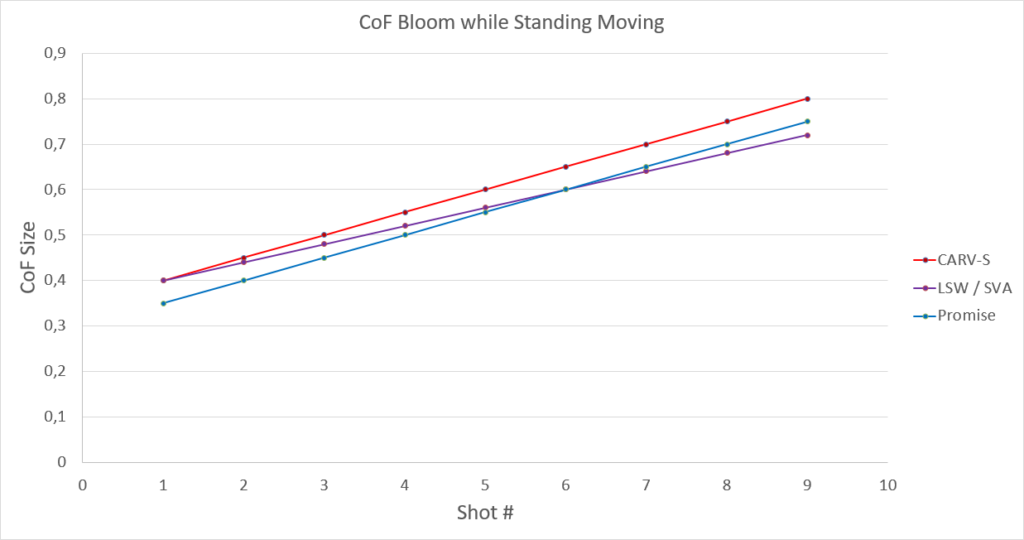
Pulsar LSW and SVA-88 have reduced ADS CoF Bloom. However, Promise starts firing at lower CoF Bloom, so it’ll have better CoF for the first 5 shots, after which Pulsar LSW and SVA-88 will match and overtake it.
I’d consider this a point in favor of Promise, since at ranges where CoF matters you won’t be firing in overly long bursts anyway, and even with the CoF Bloom advantage, it’ll take 5 more shots for the lower bloom weapons to accumulate a 0.05 degrees of CoF advantage.
Recoil
| CARV-S | Pulsar LSW | SVA-88 | Promise | |
| Vertical Recoil | 0.42 | 0.335 | 0.4 | 0.15 / 0.3 |
| FSRM (FSR) | 1.75x (0.735) | 1.6x (0.536) | 1.75x (0.7) | 2x (0.3 / 0.6) |
| Recoil Angle | 0 | 14 / 17 | 0 | -5 / 5 |
| Horizontal Recoil | 0.2 / 0.212 | 0.2 | 0.2 | 0.1 / 0.3 |
| Horizontal Recoil Tolerance | 0.7 | 0.8 | 0.8 | 5 |
| Recoil Recovery Delay | 86 ms | 86 ms | 86 ms | 0 |
| Recoil Recovery Rate | 12 | 13 | 12 | 18 |
| Compensator Access | YES | NO | YES | NO |
Promise has negative recoil scaling, meaning its maximum Vertical and Horizontal Recoil will reduce with each shot, until they become the same as minimum values. This happens at the following rates, per shot:
- Vertical Recoil Increase: -0.05
- Vertical Recoil Increase Crouched: -0.1
- Horizontal Recoil Increase: -0.05
Recoil Analysis
| CARV-S | Pulsar LSW | SVA-88 | Promise |
|
| Vertical Recoil per Second | 5.25 | 4.13 | 5.00 | 2.18 |
| -> With Compensator | 4.45 | N/A | 4.26 | N/A |
| Recoil Angle Average | 0 | 15.5 | 0 | 0 |
| Recoil Angle Variance | 0 | 3 | 0 | 10 |
| -> With Forward Grip | 0 | 2.25 | 0 | 7.5 |
| Average Horizontal Deviation | 0.174 | 0.193 | 0.193 | 0.115 |
| Maximum Horizontal Deviation | 0.448 | 0.6 | 0.6 | 1.0 |
| -> With Forward Grip | 0.130 0.339 |
0.157 0.450 |
0.156 0.450 |
0.086 0.75 |
| Tap Firing Speed, RPM | 250 | 273 | 253 | 502 |
| -> With FG and Comp. | 262 | 276 | 265 | 517 |
Presented values are calculated for 10 round bursts, and account for FSRM and recoil scaling mechanics, assuming Standing stance and average recoil per shot.
Numbers in the table are pretty telling, so I’ll highlight only the biggest outliers.
Vertical Recoil
From the get-go, it’s obvious that Promise has by far the best Vertical Recoil per Second. In fact, it’s one of the lowest values for automatic weapons, and the lowest for all LMGs. The only ones that come even in close are NS-15M2 and T32 Bull, when they’re used with Compensator.
As mentioned, these numbers assume average values and take recoil scaling into account, but Promise will have excellent VRPS even if you get the worst possible values all the time.
It’s worth noting that Promise requires only 2 shots to fully scale Vertical Recoil, if you fire them while crouching. It’s a neat feature to quickly stabilize the weapon from the get-go, though you shouldn’t go out of your way and crouch in every engagement. It’s mostly useful when you’re engaging a remote and exposed enemy from a safe position.
Horizontal Recoil
In terms of Horizontal Recoil, the classic trio is pretty close to each other, and not particularly good. CARV-S is slightly ahead of the VS LMGs, but Promise, once again, beats all three pretty soundly, and remains nearly twice as good.
Since Promise has unprecedented Tolerance size of 5 degrees, it can potentially have a huge amount of consecutive kicks in one direction, but this is unlikely to happen. The chance of 3 kicks in one direction is 12.5%, and 4 kicks is ~6%.
You’ll almost never see Promise slide along Horizontal plane for long. What’s more likely, Promise will shake around the middle, but every once in a while that middle will shift by one or two shots, and you will have to adjust your horizontal aim.
Besides, just after 4 shots, Promise will have the lowest Horizontal Recoil per Shot among all automatic weapons, and you will barely notice Horizontal Recoil at all.
Picture to the left demonstrates a typical horizontal recoil pattern for Promise, though it doesn’t take recoil scaling into account, and values are not up to scale.
On the following two pictures, you can compare the Horizontal Deviation Probability Distributions for MGR-L1 Promise, T9 CARV-S and SVA-88. Pulsar LSW would have an identical pattern to SVA-88, so it’s not listed. All weapons are presented with a Forward Grip, and the results are averaged out between tenths of thousands of simulations.
On this graph you can see that Promise spends ~85% of the time within 0.1 degrees of the original crosshair position, and about 92% within 0.2 degrees, 95% within 0.3 degrees. This is basically showing how likely you are to have 4 kicks in the same direction in a row. Statistically, Promise can go further, but it’s highly unlikely.
If you take a look at CARV-S and SVA-88 further below, you’ll that their recoil pattern is somewhat less consistent.
For example, CARV-S spends about 52% of the time within 0.12 degrees, and about 82% within 0.3 degrees, which is already slightly worse than for Promise.
You’ll notice that SVA-88 has about 10% chance of kicking all the way to 0.42 degrees.
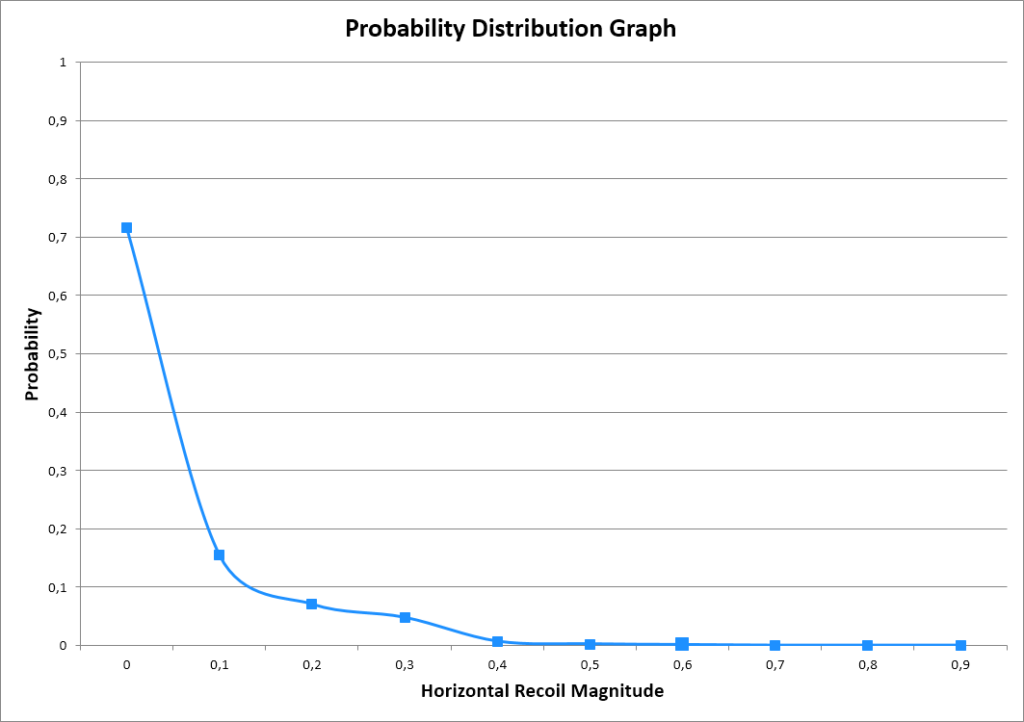
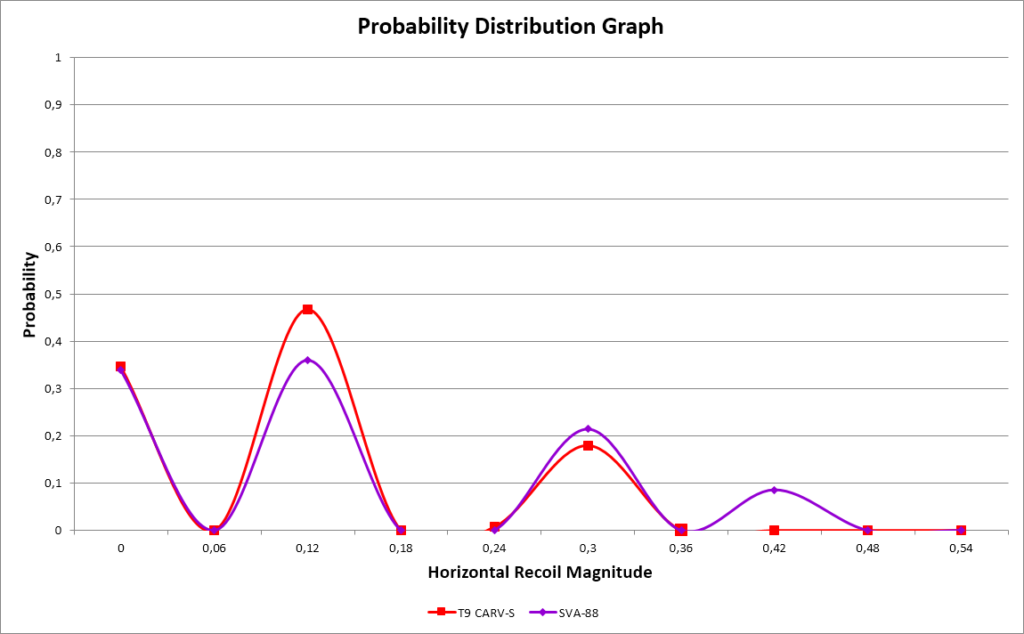
Recoil Angle
Pulsar LSW is the only LMG of the four to have a Recoil Angle. It has medium “strength” to the right, and overall doesn’t affect weapon handling in a meaningful way.
Promise is in a weird place. It has average Recoil Angle of zero, but 10 degrees of variance, so it’ll shake about a lot, but without bias to any particular direction. This will be especially noticeable and annoying during first few shots, while the recoil per shot is still comparatively large. Once recoil scaling fully kicks in, you won’t notice it much.
Tap Firing Speed
Tap Firing Speed is measured in Rounds Per Minute, same as Rate of Fire, and it depends on weapon’s First Shot Recoil and Recoil Recovery statistics.
Recoil Recovery Mechanics don’t really matter outside of tap firing or shortbursting, so Tap Firing Speed is the maximum RPM at which you can fire single shots, and still have the crosshair fully recenter between shots.
It’s a fairly useless statistic for normal gameplay, since usually you’ll fire more than 1-3 shots per burst, but it can be useful when dealing with tiny targets such as deployables, or when an exposed enemy is vastly outside of your effective range.
You’ll notice that Promise holds a huge advantage over other LMGs in terms of Tap Firing Speed, which is both due to lack of additional Recoil Recovery Delay, as well as best in class Recoil Recovery Rate.
Velocity
| Stock | SPA | HVA | |
| T9 CARV-S | 600 | 540 | 660 |
| Pulsar LSW | 620 | 558 | N/A |
| SVA-88 | 630 | N/A | 693 |
| Promise | 550 | N/A | 687* |
The classic trio is fairly close together, and has good projectile velocity, slightly above average for LMGs. SVA-88 is slightly ahead, especially with HVA, showing the weapon’s inclination towards ranged combat.
Promise is noticeably behind, and its stock velocity is below average. There is a caveat – its SPRW Ammo attachment will increase velocity by 25% at the cost of reducing magazine size from 100 rounds to 75.
Conclusion on Effective Range
All of these weapons don’t particularly shine outside of 50m, for various reasons.
| EXCUSES FOR BAD AIM | ||||
| Bad CoF Accuracy | Poor Recoil | Low Velocity | Inferior Bullet Damage |
|
| T9 CARV-S | BIG YES | SMALL YES* | NO | SMALL YES* |
| Pulsar LSW | YES | NO | NO | BIG YES |
| SVA-88 | YES | NO* | NO | SMALL YES* |
| Promise | SMALL YES | LOL NO | NO* | BIG YES |
* – requires attachment.
Due to just average DPS and LMG-tier hip fire accuracy, none of them particularly shine at closer ranges either. Their sweet spot seems to be the infamous “medium range” somewhere between 20m and 50m.
The problem is that within that range bracket ANY LMG will serve perfectly fine, including those oriented towards CQC. In fact, this is why weapons like LA1 Anchor are so popular.
Sure, CQC LMGs will be clearly inferior in terms of effectiveness at range, but it’s not a big deal. The nature of ranged engagements is that you often can just walk away into cover from an unfavorable fight, especially thanks to Heavy Assault’s overshield.
And if you’re engaging in favorable conditions, having slightly longer TTK is not a big deal. Thanks to LMGs’ large mags, you can keep sending rounds down range until target is dead. At worst, you’ll miss out on a kill, but you won’t die to your weapon’s inaccuracy.
Situations where you have to fight effectively or die, and don’t have an option to run, are much more common in CQC, hence why CQC performance is generally preferable. Additionally, as a HA you’re expected to aggressively push the frontline, and that’ll often mean engaging at close ranges. If you want to be useful to your faction, you don’t really get an option to play around your effective range, and purposefully stay out of close quarters.
Open field battles usually aren’t required, but even if you get stuck in one, you’d probably want to equip a ranged LMG or a Battle Rifle. Or even switch to Infiltrator.
This is a general philosophical problem with any non-CQC LMGs, what I’d like to refer as “the LMG problem”.
Utility Stats
Ammo Capacity
| Magazine Size | With Ex. Mags | Ammo Pool | |
| T9 CARV-S | 100 | 200 | 400 |
| Pulsar LSW | 75 | 150 | 300 |
| SVA-88 | 75 | N/A | 300 |
| Promise | 100 | 150* | 500 |
* – uses Smart Feeder ammo attachment, which increases Reload Time by 0.325 seconds.
Nothing especially noteworthy. VS LMGs lag behind in terms of capacity, while Promise has the largest Ammo Pool to make sustained fire less punishing, which is the general theme of the weapon.
Note that Promise has two Ammo Attachments that affect Magazine Size, but no effect on damage.
Reload Speed
| Short Reload | Long Reload | |
| T9 CARV-S | 4.64 sec | 5.58 sec |
| Pulsar LSW | 3.09 sec | 3.90 sec |
| SVA-88 | 3.38 sec | 4.70 sec |
| Promise | 4.75 sec | 5.78 sec |
| -> With Smart Feeder | 5.08 sec | 6.10 sec |
Notes:
- Pulsar LSW enjoys the fastest reload, which definitely makes it more convenient.
- SVA-88 is not that far behind, but it has a much bigger Long Reload penalty.
- Surprisingly, Promise has the longest Reload, especially with Smart Feeder attachment. Running SPRW Ammo and having to reload more often is likely to cause issues.
- CARV-S has typically LMG-tier slow reload times.
Equip Time
| CARV-S | Pulsar LSW | SVA-88 | Promise |
|
| Equip Time | 1.1 sec | 0.9 sec | 0.9 sec | 1.25 sec |
| -> With Forward Grip | 1.2 sec | 1.05 sec | 1.05 sec | 1.4 sec |
| Unequip Time | 0.25 sec | |||
CARV-S is about average for an LMG, while Pulsar LSW and SVA-88 are slightly below average. Having a short Equip Time is especially important for Heavy Assaults, who tend to switch to their Rocket Launchers and Med Kits a lot. And this is where Promise drops the ball. Even such a giant as Gauss SAW with a Forward Grip has Equip Time of 1.25 seconds.
Long Equip Time of the Promise will definitely let you down in close quarters, and whenever you’re switching back and forth, you have to be ready to drop everything and equip your sidearm instead.
Comparisons to Competition
Overall, none of these weapons look particularly appealing, and this is mostly the fault of their mediocre damage model; it lacks focus. Why would you ever use a 143 @ 698 weapon over 167+ damage LMGs, which are much more effective at the same medium range bracket and beyond?
143 @ 698 LMGs do hold some advantages. For example, higher RoF makes a weapon more consistent, especially in close quarters. They’ll have slightly better recoil than CQC-oriented LMGs, and higher DPS than range-oriented LMGs, though that weapon class is another can of worms entirely.
None of this is really enough to compensate for inferior damage. Let’s go weapon-by-weapon and see what kind of competition they have to go against.
TR are left with TMG-50 as the only 167 damage option. I personally hate that it has 2 tiers of damage degradation and relatively poor recoil, especially the Tolerance. However, even TMG-50 will fare better than CARV-S at medium range and beyond, though there will be a significant reduction in effectiveness in close quarters, especially when comparing TMG-50 with HVA to CARV-S with SPA.
As another alternative, MSW-R has almost the same recoil as CARV-S. There are some noticeable disadvantages in ranged combat, such as smaller Magazine, lack of HVA and lower velocity. However, MSW-R comes with massively better performance at closer range, and makes a decent competitor overall.
For VS, there is a similar situation for Pulsar LSW / SVA-88 and Orion VS54, which actually has slightly better Horizontal Recoil, though noticeably stronger Vertical Recoil and no Ammo attachment options, as well as smaller magazine battery.
Flare is generally frowned upon, but even it will be better at medium range than both of the 143 @ 698 LMGs.
For NC, you can take pretty much any 167+ damage LMG and it’ll be more effective at medium range, and depending on choice, better in CQC or at longer range. However, only the Promise has such low and smooth recoil, which is rather uncharacterestic for NC, and some people will certainly enjoy its controllability.
The recoil is non-existent. It’s almost a laser beam. It’s not a very strong laser beam, but a laser beam, which is good if you can aim.
– KosViik
If you’re looking for combat effectiveness, I’d say it’s better to learn to deal with recoil, though. Promise has a couple of other cool perks, such as limited Max ADS CoF and best in class Tap Firing speed, but those aren’t easily leveraged as advantages.
Closing Thoughts
On overall spectrum of the effective range and effectiveness within that range, 143 @ 698 LMGs are between CQC LMGs and 167+ damage LMGs with ~matching DPS. The problem is that these waters are so muddy that there’s no reason to settle for this mediocre option.
Something like GD-22S will perform much better at range, and not particularly worse in CQC. And Anchor is basically a meme at this point, being one of the most versatile LMGs in the game.
143 @ 698 LMGs seem to be in a bad place. They need to have their Minimum Damage Range extended at least to the levels of Assault Rifles, and their advantages over CQC LMGs in terms of recoil and controllability are not big enough. Hell, in some aspects they are even worse!
Pretty much the only real advantage of 143 damage weapons at medium range is consistent BTK when engaging with headshots, and except for Promise, none of these guns are particularly good at it.
As far as how 143 @ 698 LMGs relate to each other, I’d rank them as follows:
Promise > Pulsar LSW > SVA-88 > CARV-S
Overall, Promise is a unique case of a weapon. Its recoil pattern is one of a kind. Typically, LMGs have a ton of recoil, and while there are some exceptions, they usually come with below average DPS. I’d say Promise is a good weapon for newbies and casual players, and has even some role-play potential with its sustained fire feature.
There are some noticeable disadvantages, such as long Reload and Equip times. Promise also lacks attachments to boost the damage ranges, though as we’ve established, it’s not a big deal for this damage model.
Promise also lacks an option to equip a Suppressor, not that it would be a good idea with this damage model.
Perhaps the biggest disadvantage of the Promise, and something I haven’t mentioned yet, is the inconsistency of its first few shots. First shots are often the most important, and can easily decide the outcome of a firefight, and between high Recoil Angle Variance and highly variable Recoil, there’s definitely some annoying shake.
It’s not so bad, though. Realistically, even if your get the worst possible Recoil values every time, Promise will still have less recoil than other 143 @ 698 LMGs. It’s just that it can be annoyingly inconsistent, albeit on a small scale, and it still goes against what a competitive player would look for in a weapon.
As a final thought, don’t be discouraged by my negative outlook on these weapons. In the end, they’re perfectly capable killers. It’s just the differences between PlanetSide 2 weapons are so minuscule, that every little detail gets blown out of proportion. Worse is worse, even if it’s just by a few percent.







